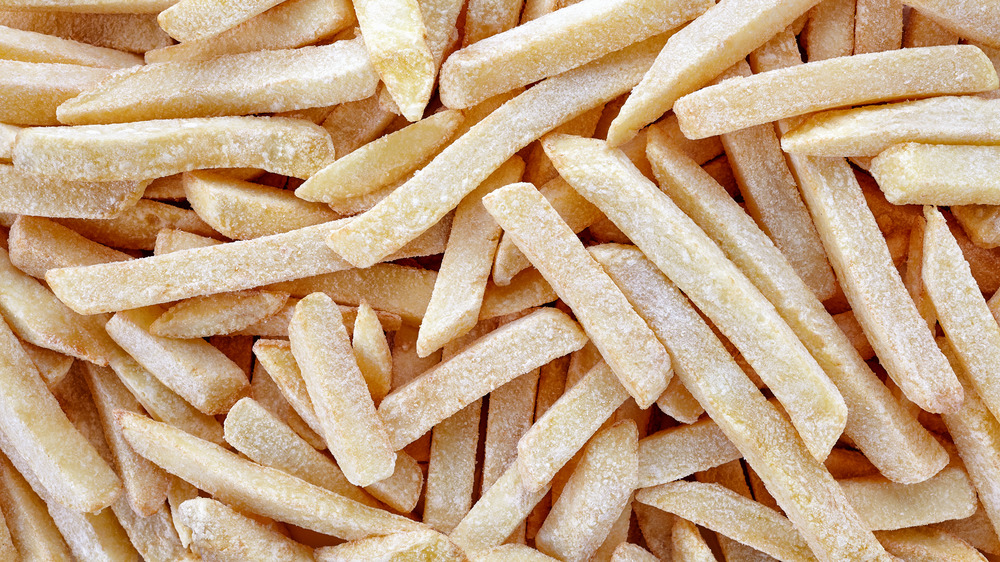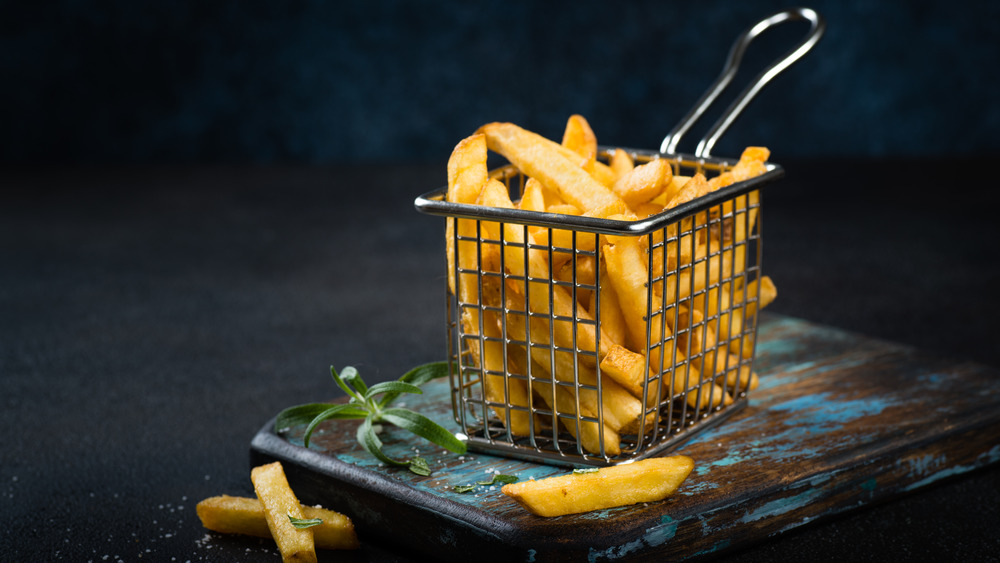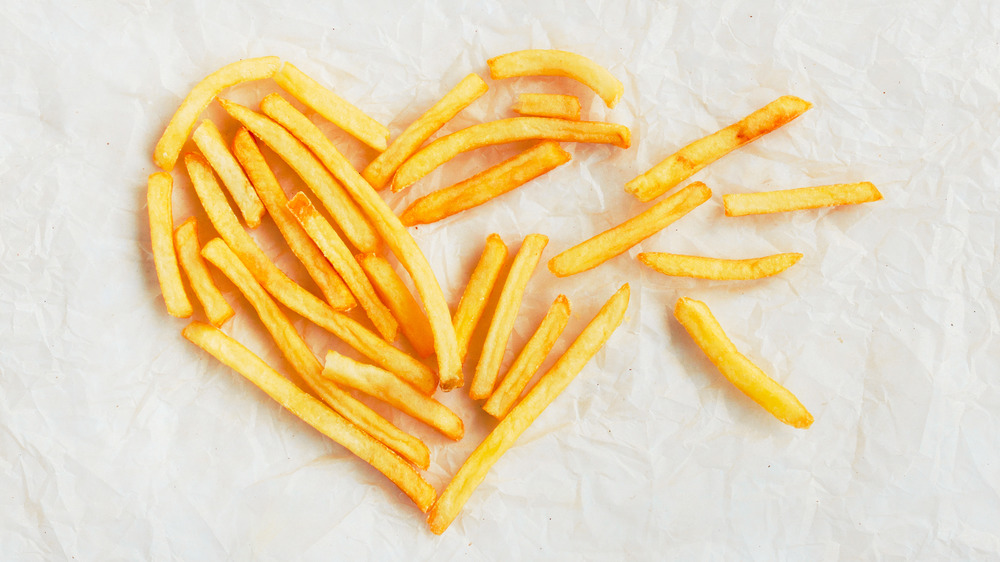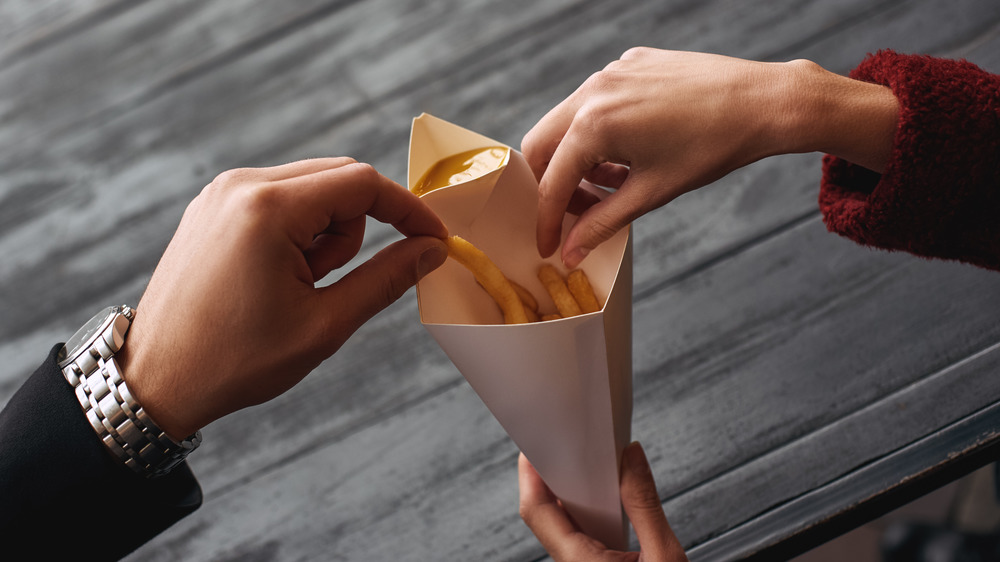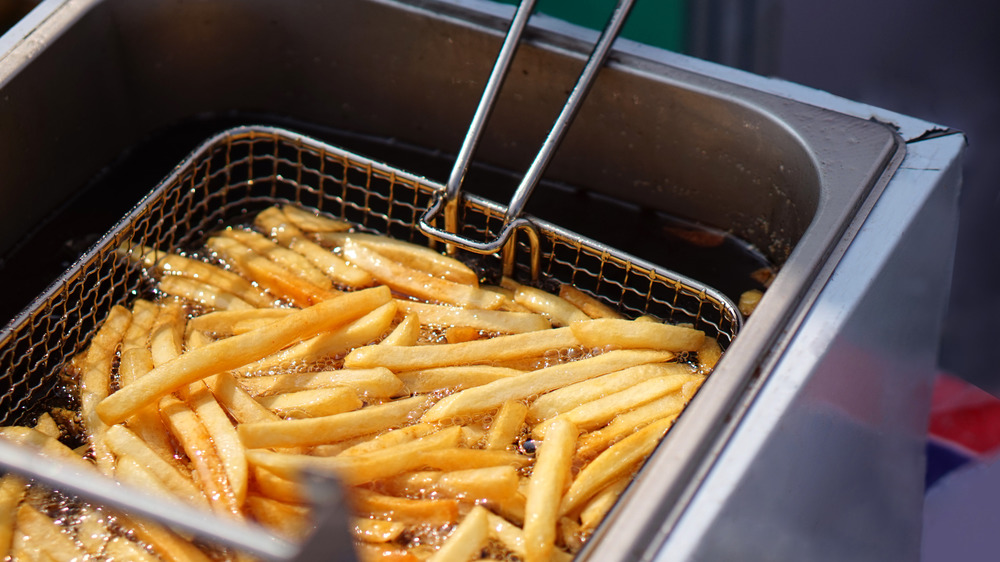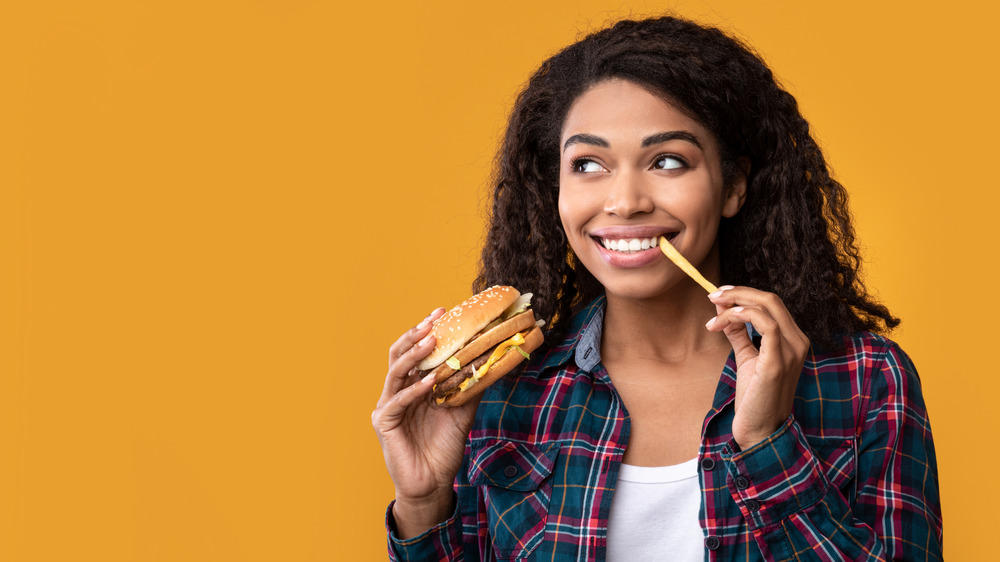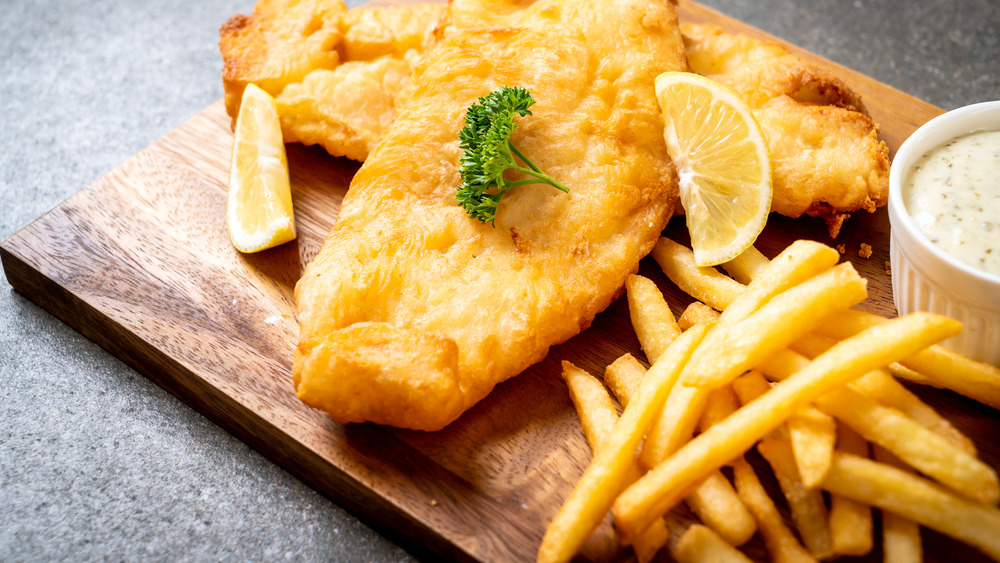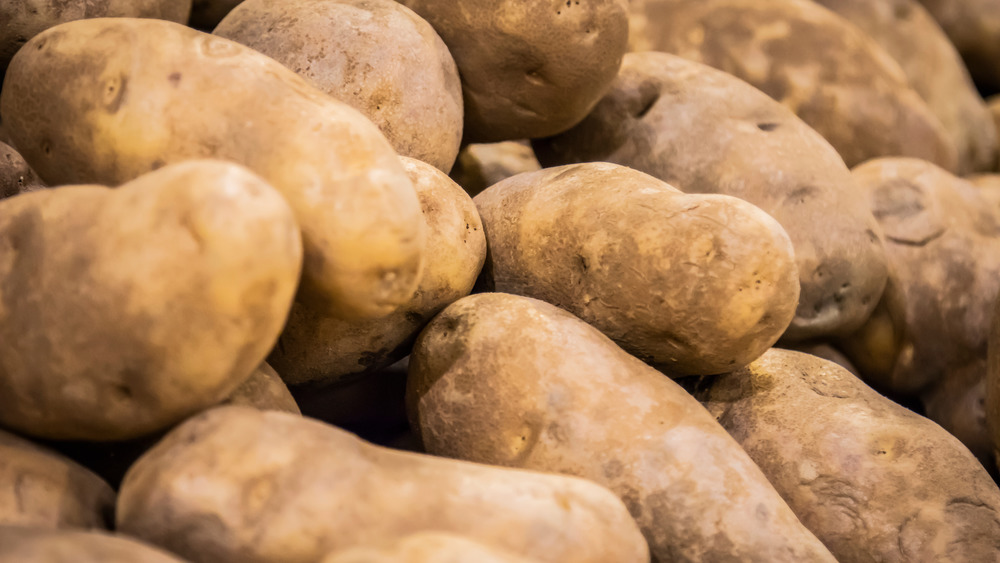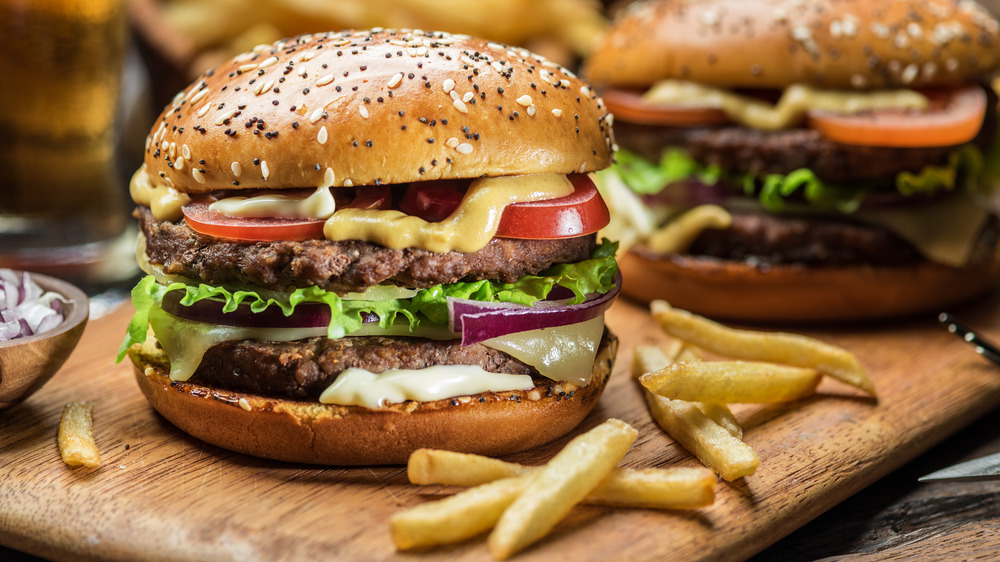Sneaky Ways Restaurants Could Be Scamming You On French Fries
French fries are arguably one of the most beloved foods of all time. No matter what time of day, they make for a perfect snack. You can eat them all by yourself, or share them with friends if you're feeling especially generous. They're pretty versatile, too. Load them up with chili, melted cheese, sour cream, and bacon bits, and suddenly you've got a filling entrée. French fries are also the BFF to any money-making restaurant combo, because honestly when you have the choice, who actually chooses the salad?
Unfortunately, french fries are also one of the easiest foods that restaurant owners can cheap out on or, more charitably, mess up during the cooking process. For the most part, you as a customer don't realize something's wrong with your fries until it's too late. Unless they're presented on a plate, most people can't analyze the entire contents of their fry bag until they've popped the first few into their mouth. Here are the sneaky ways that restaurants could be pulling a fast one when it comes to your french fries.
Many restaurants serve frozen french fries
High volume restaurants often use frozen french fries because they are simply a cheaper option compared to paying for the labor that goes into washing, slicing, and dicing each potato by hand. When restaurants purchase frozen french fries, they just don't need to worry about the time sink of prepping spuds, though that oftentimes means the quality of the resulting french fries just isn't as good as the hand-crafted, freshly made stuff. As AG Daily reports, fast food giant McDonald's is one such restaurant that starts with frozen french fries that are already pre-peeled, cut, and dried in such as way as to get the starch content just right.
According to Elite Restaurant Equipment, frozen french fries began replacing fresh-cut fries as early as the 1940s. McDonald's began using the frozen version in 1967 and, since then, fresh-cut french fries are a thing of many fast food restaurants' pasts. If you're still looking for an authentic hand-cut bath of fries, you're most likely to find some at a small mom n' pop shop as opposed to the quality of fries at a big name chain restaurant.
Some french fries are so salty, you need to order drinks
Unless you specifically request "no salt" with your order, the majority of restaurants salt their french fries once they come out of the deep fryer. But as Forbes points out, the salt content found in fast foods, like french fries, has actually increased dramatically over the last 30 years. According to a study conducted by Megan McCrory and colleagues at Boston University, sodium levels have skyrocketed in the last three decades to "broadly detrimental" effect. Now, a typical burger and fries combo account for roughly 75 percent of your daily salt intake. Of course, the larger size fries you order, the more salt you'll find sprinkled on them!
According to the American Heart Association, Americans eat more than 3,400 milligrams of sodium every day. For reference, that's more than double the ideal amount for healthy hearts, which is no more than 1,500 mg per day for most adults. Plus, the saltier the food, the more likely you'll be influenced to order some kind of drink to go with your meal. Not only is the salt content bad for your health, but you may be pushed to order an extra item you didn't really want in the first place.
Restaurants leave you with the leftover french fry bits
The only thing worse than reaching the end of your fry carton is reaching the halfway point, only to realize that what's left are those sad, little broken bits of potato that can hardly be called "french fries" in the first place. Broken fries, as it turns out, are actually part of a larger problem. As Food Management reports, frozen french fries are extremely brittle. This means that, if they're dropped during the shipping and handling process, up to one-third of the contents can break into those disappointing little shards.
The USDA also has its own set of exhaustive requirements regarding french fry length, ranging from extra long to short. Finicky as this may seem, these details make a real difference for diners. Fries that are consistently long mean more fries on your plate, for one. They also require less oil to fry, which is why workers tend to handle deliveries with care in an effort to save on oil.
Still, uncautious restaurants can mean that french fry bits can also make their way into your fry cup. This can happen if the deep fryer oil isn't cleaned daily. When a new batch of french fries is lowered into the deep fryer, if the floater fries are still in the fryer, and so they'll be added to the basket of fresh ones and end up in your order. Those itty-bitty fry fragments could mean the deep fryer needs a deep clean.
Restaurants might not fill your fry cup to the top
Some restaurants stuff french fries into the carton until it looks like it might burst, and still give you extra fries floating at the bottom of the bag for the road. Others trick you into thinking your fry cup is full by carefully arranging the french fries like a precarious game of Jenga, according to the NY Daily News.
Apparently, as one commenter on r/AskReddit reported, McDonald's employees were taught to pinch the fry carton "just right", resulting in the fry cups looking full when they actually weren't. They were outed by a disgruntled customer who actually dumped the fries from the container and re-arranged them himself, pointing out the obvious empty space in the cup. While Mcdonald's denied the trick exists when speaking to HuffPost, anyone who's ever ordered a large fry at the drive-thru and taken a peek inside can probably confirm that the trick is often sadly real.
Some french fries are cooked in dirty frying oil
Have you ever bitten into a hot french fry, only to find that something just doesn't taste right? Unfortunately, no amount of ketchup, vinegar, or dipping sauces can mask the odd flavor that's hounding your much-anticipated treat. That could be because they were cooked in some truly nasty fry oil.
Similar to drinking burnt coffee, it's easy to spot when french fries are cooked in dirty, old deep fryer oil. Oil is extremely hydrophobic, meaning it repels water, as Serious Eats points out. The freshness of the oil is connected to its ability to keep from completely saturating the food. When the oil becomes too dirty after it's been re-used, its hydrophobic qualities start to break down. The dirty oil starts to soak into the product and greasy french fries and other foods result.
In the case of a naturally-starchy french fry, dirty oil often changes the color of the finished spuds from gold to brown. The fries also likely won't achieve the desired crispy texture, because too much oil has gotten into the potatoes. Hence, soggy, gross-tasting fries. While oil can be reused and there's a handy oil cleaning hack for home cooks, eventually it does need to be replaced. A good indicator is to give oil the old sniff test — if there's a musty or fishy smell, it's time to toss the oil. However, it's possible that budget-conscious restaurants may be pushing that line a bit too far.
French fries aren't always cooked properly
Everyone's got a different taste, even when it comes to french fries. Some people like their fries extra crispy. Others like them slightly softer, similar to the texture of the home fries you have with breakfast. Whichever style you prefer, it's very obvious when a french fry is truly undercooked, and that usually happens when the prep process is overlooked. If a restaurant serves fresh-cut fries, there are a few steps to keep in mind to achieve the perfect french fry, Food & Wine says. Fresh cut potatoes are incredibly starchy. In order to remove the excess starch, they need to be soaked in a cold water bath first. If this step is ignored by a time-crunched kitchen team, you're likely to receive a plate of fries that are stuck together. This means they're not going to be as crispy as they could have been, simply because only one side will have been fully cooked!
Additionally, unlike frozen fries which have already been through a blanching process, fresh-cut fries can't just be cooked at one temperature for the entire duration of the frying process. Many restaurants use a two-step frying process for fresh fries, where the fries are first lowered into a slightly lower oil temperature for a few minutes until they're tender but still white. Then, they should be transferred into a hotter oil to finish off the frying process. The end result should be a deliciously crispy fry, every time.
Battered french fries can get soggy if restaurants don't move fast
A lot of fried foods, french fries included, are coated in batter in an attempt to make them extra crispy or to provide more flavor. Yet, that trick can backfire pretty quickly.
You see, batters also provide an extra barrier between the french fry and the frying oil, which means they lock in extra moisture that can bring on the dreaded sog. During the frying process, steam will escape from the french fry, which should result in a nice, crispy coating. But, if the fries aren't served piping hot once they're ready, they could start to get soggy. As HuffPost points out, once the fries start to cool, any moisture that's been retained during the frying process can get trapped between the batter and the potatoes. With nowhere to go, they eventually just turn into water droplets instead of steam and you're left with limp, lifeless fries.
While restaurant fries are usually safe, fast food fries are the most likely to be guilty of this french fry sin, especially because you tend to get a mix of fresh fries and the stragglers that didn't make it into the last takeout bag.
Some restaurants don't use the right potatoes for french fries
Loaded baked potato lovers know that there's a very specific type that has to be used in order to create the perfect version of that fluffy, melt-in-your-mouth appetizer. As Kitchn reports, different kinds of potatoes result in dishes that have different kinds of tastes and textures. Yes, that includes french fries. According to The Spruce Eats, russet potatoes, also known as Idaho potatoes — though the two are actually distinct — are one of the best kinds of potatoes to use for making french fries because they have a very high starch content.
The higher the starch content, the more crispy the finished french fries will be on the outside, and the fluffier they are on the inside. Russet potatoes also have a tendency to maintain their shape (again, because they're super starchy), which means they're less likely to break apart during the frying process. If your fries are sad and short, it could be that the restaurant is using a different kind of potato, like red potatoes or new potatoes. These varieties are waxier than their russet cousins and retain quite a bit of moisture that can result in — you guessed it — soggy fries.
You might actually be eating day-old french fries
When you eat out at a restaurant, you always hope that what you're ordering is fresh. Despite cooking a fresh batch of fries every time, it's inevitable that you're likely going to end up with a few fries that were left in the bin from the previous order. But, as it turns out, that's not the worst that could happen.
Apparently, there's a sneaky way to give day-old french fries a second chance at life, according to Food Hacks, which claims that day-old, cold, soggy fries can be revived by heating them on the stove in a skillet. Using high heat and a little bit of oil, french fries can become crispy again. While we really hope that restaurants aren't doing this to customers, it's not beyond the pale to think that a frantic restaurant kitchen might try the same trick.
Even if a restaurant isn't doing this, they could be using other tricks to keep fries around for longer than you might want. As Food Management also points out, a few years ago, french fry manufacturers introduced a clear, transparent, tasteless coating that the french fries can be tossed in. The objective is to enhance the fries' heat retention, and this is a great trick for restaurants that need to hold fries for a long period of time.

